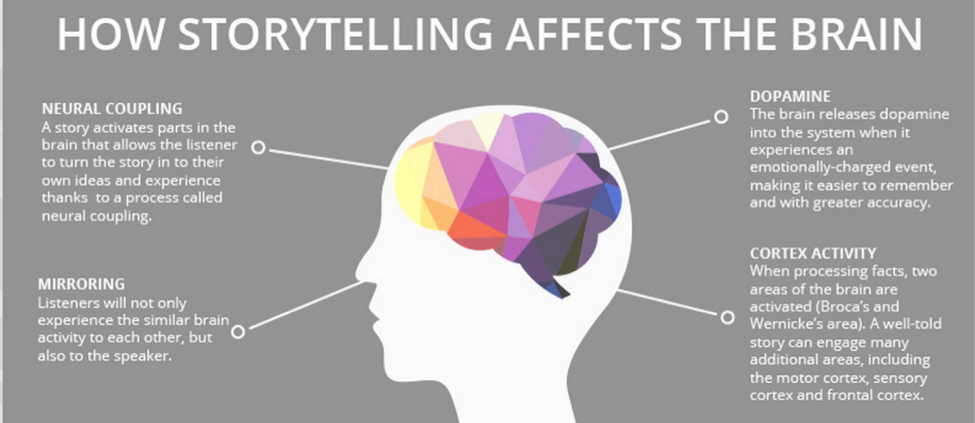
*As originally seen on Forbes.com
We’ve all seen them. Emotionally flat presentations. Emotionally devoid corporate mission, vision, and value statements that are simply wall art. They’re not memorable. And even if the team has been asked to memorize them, even recite them, but if you ask what they mean, you’ll get blank stares.
Why? There’s no emotion.
There’s no story.
What’s your favorite movie? I’ll bet you can enthusiastically tell me all about it, even if you haven’t seen it in years. Stories are like nutrition for our souls. We remember them and love them. They have deeper meaning for us. On YouTube, there’s a wonderful video clip of a group of marines belting out the lyrics to the theme song from Disney’s Frozen. Who would have thought combat soldiers could relate to a Disney princess?

Shutterstock
And then there are company stories. Many of us have heard the story about a Nordstrom’s customer returning a snow tire, and the customer service rep handling that request happily, even though Nordstrom doesn’t sell snow tires. We hear the story and we don’t need to be told that Nordstrom’s values customer service. We know already, we have the story.

Source: www.educatorstechnology.com
What Do You Love In A Story?
Notice what makes stories memorable for you. For most people, the stories we remember have some sort of emotional impact on us. They have this impact because we can relate to the hero and the storyline in some way. The stories you tell about your organization need to be positively impactful too. Neural coupling enables us to connect to the story and personalize it. We connect to the storyteller via mirror neurons, we get deeply engaged and feel/hear/see and even smell/taste what’s happening in the story too. And dopamine, a feel good neurotransmitter gets released when a story is emotionally engaging. And that’s just a start!
Here’s the storytelling recipe my client’s love when they are crafting company stories.
Step 1: Focus On Your “Story Customer” And Their Context
Who is the story for? Customers? Team members? Take a moment and think about the recipient of the story, what is their context? Notice the situations they are in, and make sure they can relate to your stories, tell stories where they can see themselves as the hero(ine) of the piece.
When you tell your story, choose the communication vehicle that fits their context. For example, one client’s target customer is parents of small children and they told their stories via Mommy blogs. Telling the same story on LinkedIn would probably not have been nearly as effective.
Step 2: Make It Authentic
Fabricated stories don’t usually have the same emotional impact as the real ones. You just can’t make some of those quirky details up, as Mark Twain said “Truth is stranger than fiction”. People like stories that have enough specific details to create a picture in their mind. Have a contest and ask your team to submit the stories of times when your organization’s values were demonstrated. Develop the stories that have the most emotional impact. Remember the brain and emotional engagement!
To make it really memorable it also helps if the story is told by a trusted member of the community. For example, stories told by customers about their own experience are going to feel more genuine and impactful than ones that you publish yourself.
Step 3: Give The Story Movement
Start your story with a problem or situation and then tell how that problem is resolved. Make sure the story goes from a problem (or less than fully desirable situation) to a more desirable outcome.
The more challenge in the story, the more interesting. The more distance between the starting point and the ending point, the more dramatic and compelling.
Step 4: Make It Value-Oriented
What value, insight, or service resolved the problem? For marketing stories, they might be about how your product or service helped in a unique or challenging situation. Ask yourself: what desirable outcome happened for the protagonist?
Make sure your story demonstrates your values. Other stories might be more funny, but you want to promote the ones that demonstrate your values, who you are, how you’ll show up for others.
Step 5: Test The Efficacy
Try it out. Does the story communicate positively? Specifically test your story on a representative group of recipients to make sure it has the intended meaning and impact.
The internet makes this pretty easy to do, but make sure you have tried out your story in a non-recordable way before you “go big.”
The Net-Net = C.U.R.V.E.
Not every story will meet all of the below criteria, But I like to check my clients’ stories against the CURVE model to make sure they are creating a positive experience.
C for Curiosity, does the recipient want to know what happened?
U for Urgency, does the story create a sense of “must get this done now!”
R for Relevance, is the story relevant to the recipient’s situation or context?
V for Value, does the story reflect my values, is the story valuable to the recipient?
E for Emotion, does the story have an emotional impact? Is it funny, scary, surprising…?
Your Turn
People love to tell stories, they are potent engagement and teaching tools. Follow the above guide and make sure the stories being told about you and your organization are sending the right message!






